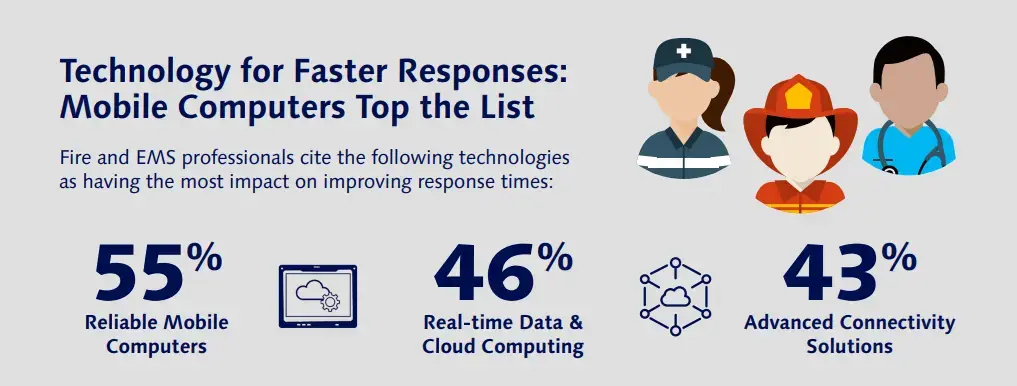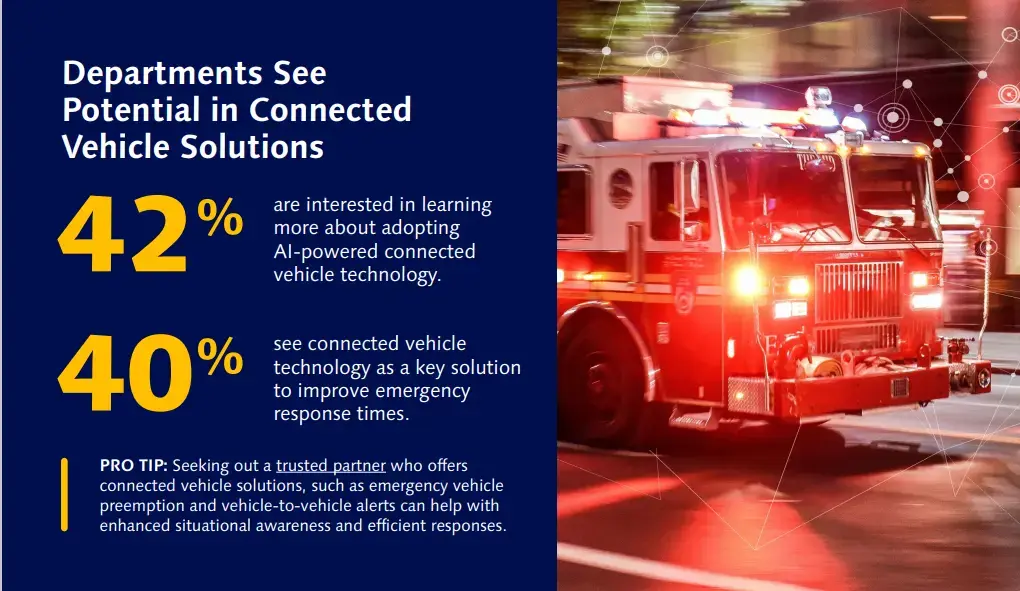With increasing call volumes and limited resources, fire and EMS professionals face challenging times. Now more than ever, they need the flexibility to work and communicate swiftly and effectively. Our recent survey of more than 100 fire and rescue professionals uncovered their top challenges and where they see opportunities to use technology to operate more efficiently.
Eighty percent of the professionals surveyed identified recruiting, retention, and training as their primary challenges, while managing budgets, funding, and procurement ranked second. Though they see the potential for technology to offer support in these areas, those surveyed also identified several roadblocks standing in the way of successful implementation.
Let’s dive into the top tech priorities identified in the survey, as well as barriers to deployment and where fire and rescue professionals see the greatest potential for technology to drive efficiencies in the years ahead.

Top 3 Tech Needs for Fire and Rescue Professionals
The respondents identified three priority technology needs: fast and reliable communications systems, situational awareness solutions, and streamlined reporting & documentation applications.
Fire and EMS professionals require reliable communication tools to make split-second decisions, coordinate complex responses, and relay critical information to other first responders, dispatch, and hospital staff. Public-safety broadband with priority and preemption, together with LMR interoperability, helps maintain continuity during major incidents.
To communicate with dispatch and others, they need advanced mobile devices powered by 4G LTE and 5G technology to share critical information, including photo and video feeds, quickly and reliably. Transmitting video gives first responders context into how a situation is unfolding in real time.
When the first-arriving unit discovers they need backup, they can use modern mobile devices to send real-time video to incoming units, or the operation center who can then use the feed to strategize best actions upon arrival. Agencies should also apply clear retention policies and PHI safeguards for livestreams and ePCR to align with policy regulations.
Respondents also indicated a desire for enhanced reporting documentation apps to streamline time‑consuming tasks. The latest solutions optimize CAD/RMS entries, offer NEMSIS (National Emergency Medical Services Information System) & NFIRS (National Fire Incident Reporting System) compliance, and support as ePCR workflows. This helps crews check reports, submit maintenance requests, restock gear, verify secure device mounts, and file incident reports faster and with fewer errors so vehicles and crews are ready for the next call to service.
Enhancing Response Times with Advanced Technology
In addition to identifying solutions to enhance day-to-day operations, the survey respondents specified three technologies with the greatest potential to enhance response times: mobile computers, real-time data and cloud computing, and advanced connectivity solutions.

The latest rugged mobile computers address all three needs. Our laptops, 2-in-1 tablets, and handhelds work well in the harshest environments, with rugged features and advanced connectivity capabilities to support seamless collaboration and efficient, coordinated responses.
Mobile Computers allow for the collection and digitization of numerous data points, such as building floor plans and reports from past fires in a particular building. With the latest CPU, GPU, and NPU technology advancements, laptops and tablets can run AI-powered software to interpret all of these data points and deliver insights faster to support more informed decision-making and strategic action. First responders can also use the built-in GPS on the latest devices to plot the most efficient paths to incidents and get to the scene as seamlessly as possible. Tablets equipped with thermal cameras, like the TOUGHBOOK G2, can read surface temperatures to assess a potential fire spreading through walls without putting crews at risk.
Fire and rescue professionals operate in challenging field conditions that can interfere with connectivity. That’s why many departments are looking for broadband technologies paired with 5G/4G LTE with operational safeguards: store‑and‑forward for video and ePCR, multi‑carrier or eSIM failover, offline maps, and mesh/vehicle repeaters for large or indoor scenes.
The Value of A Trusted Tech Partner
Budgets are shrinking, call volumes aren’t, and everyone already has three jobs. That’s the reality most fire and EMS leaders identified in our survey. The blockers to adopting new tech were familiar: money, clarity, and change. The fix isn’t a magic widget: it’s a trusted technology partner who can help departments choose the right tools, fund them, roll them out, and keep them working.
Technology partners can help agencies identify the right hardware, software solutions, and services, while ensuring compliance with the latest security guidelines. Panasonic Connect offers a range of professional services that can be tailored to each customer’s needs. Agencies can receive insights into the best tools for them, with information on how to deploy the technology and train staff in the new tools.
Tech partners who offer flexible payment models and grant-writing support can also help departments level up their tech stacks. Subscription models allow them to pay for technology hardware, software, and services over time as part of regular operating costs (OPEX), instead of making a larger upfront payment. The point isn’t novelty, it’s predictability and lifecycle discipline. When your plan includes refresh cycles, image maintenance, and repair logistics, crews gain access to reliable gear and leadership avoids having to ‘buy the same laptop three times.’ TOUGHBOOK-as-a-Service (TaaS)-style programs exist specifically for this use case.
The Future of Emergency Response Rests in AI-powered Connected Vehicles
Survey respondents see AI-driven connected vehicles as a high-impact next step. By strengthening vehicle-to-vehicle (and infrastructure) communication, these systems can anticipate hazards, reduce collision risk, and enable safer, more efficient responses

With broader adoption of connected vehicles, the likelihood of collisions declines and the burden on first responders does too. When combined with AI, connected-vehicle tech can tie into the department’s dispatch system (CAD/AVL) to generate optimal routes and automatically request signal priority, clearing the way without manual preemption. The net effect is safer, more efficient response times.
Realize Technology’s Potential
Our survey of fire and EMS leaders confirms what many already know: staffing and budgets are tight. Even so, respondents see clear upside in modern tools, from resilient communications to rugged mobile computing, to ease workloads and improve situational awareness.
The sticking points in the survey are familiar: limited dollars and unclear ROI. The fastest way through both is a trusted technology partner who maps solutions to the mission, ensures compliance, and manages deployment, training, and support. With tailored professional services, flexible subscriptions, and grant guidance, departments can modernize with confidence all by protecting today’s budget, safeguarding tomorrow’s investments, and preserving what already works.
For the full findings from our survey of fire and EMS professionals, check out our infographic.
